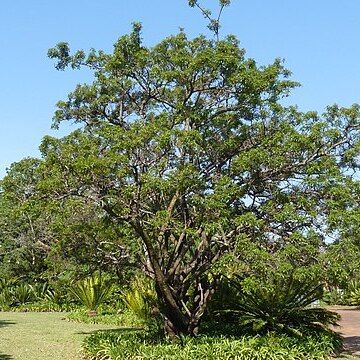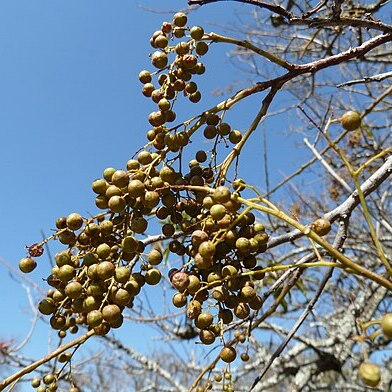A shrub or small to sometimes large single-stemmed semi-evergreen tree reaching 23 m in South Africa. Bark smooth, older branches often spinous. Leaves trifoliolate; petiole glabrous, rarely pubescent, shallowly canaliculate above, (8-)41(-91) mm long; leaflets petiolulate, membranous, glabrous, concolorous, dark green sometimes turning red before felling, hypostomatous; lamina ovate to ovate-lanceolate, base cuneate to attenuate, apex acuminate, rarely cirrhose; margin entire, undulate, often minutely serrulate; venation simple craspedodromous, midrib prominent below, impressed above, secondaries slightly prominent below; terminal leaflets (30-)85(-130) x (13-)28(-54) mm, lateral leaflets (11-)55(-103) x (6-)22(-46) mm. Panicles much branched, multiflorous, males chiefly terminal, up to 200 mm long, females shorter, chiefly axillary. Flowers normal. Drupe circular, globoid, shiny, dark reddish brown, 2.9 x 2.8 to 7.0 x 6.3 mm.
Tree or shrub, 1-23 m high; single stemmed, evergreen, bark smooth, brown, older branches often spinous. Leaves petiolate, trifoliolate; leaflets petiolulate, membranous, glabrous, dark green turning red when falling, ovate to ovate-lanceolate, margins entire, undulate, often minutely serrulate. Inflorescence much-branched panicles; males mainly terminal, 200 mm long; females mainly axillary, shorter. Flowers minute, yellowish green. Flowering time all year. Fruit a drupe, globoid, shiny, dark reddish brown.
A shrub. It grows 7 m high. The branches are often hanging. The leaf stalks are slender. They are 8 cm long. The leaflets have short stalks. They are oval and narrow to the tip. The edge is often wavy. They are 10 cm long by 4 cm wide. The flowers are at the ends of branches. They are in open branched groups. The fruit are round and 4 mm across. They are shiny red.
Shrub, or tree up to 23 m high. Leaflets petiolulate; lamina ovate to ovate-lanceolate, base cuneate to attenuate, apex acuminate; terminal leaflet (30-)85(-130) x (13-)28(-54) mm. Panicles much-branched, multiflorous. Flowers yellow.
Dioecious, deciduous shrub or tree to 23 m. Leaves trifoliolate, leaflets stalked, ovate to ovate-lanceolate, weakly undulate. Flowers pale green. Drupes round, shiny.



